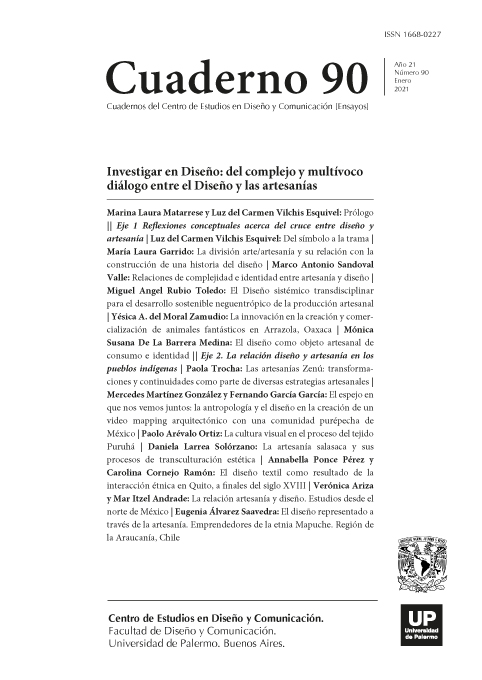Relaciones de complejidad e identidad entre artesanía y diseño
Abstract
In certain situations, the plastic arts, crafts and design have narrowed their activities to form relationships with different scopes; At the moment, the fading of its borders has gained strength to denote mixed phenomena in the conception of the value of use, the exchange value and the symbolic value of the resulting objects. This writing begins conceptualizing these disciplines in the current context and recognizes the plurality of the manifestations, to later base their tasks as elementary in the construction of the material and cultural life of their society. Reflections are made from a social perspective on the validity of their activities through the object expressions that actively participate in the daily life as proctors of identity in the life of human beings, being artifacts elaborated, identified, used, desired and interpreted; carriers of stories, agents builders of experiences in reality. Through a critical analysis of the interrelationships where craft and design participate, it reveals a subtle and complex correspondence to its social and cultural edge, which highlights the conceptual and practical scope of traditional knowledge of craftsmanship, in relation to to the procurement of design sense.
References
Alexandre, C. B. y otros (2017). New design and manufacturing technologies for craft products. Manufacturing Engineering Society International Conference. Pontevedra, Spain: MESIC
Acha, Juan. (2009). Introducción a la teoría de los diseños. México: Editorial Trillas.
Augé, M.( 1993). Los no lugares. España: Gedisa.
Baudrillard, J. (1969). El sistema de los objetos. México: Siglo Veintiuno editores.
García Canclini, N. (1990). Culturas híbridas. Estrategias para entrar y salir de la modernidad. México: Editorial Grijalbo-CNCA.
Gómez, Y.N. y Pérez, C.A. (2009). “Ambiente, sociedad y diseño: Tendencias”. En: Revista Académica e Institucional, Páginas de la UCPR, 85: 77-94.
Hall, E. (1994). La dimensión oculta. México: Siglo Veintiuno editores.
Horcasitas Olvera, C. (2011). La ciudad imaginada: un acercamiento antropológico a la semiótica urbana. Recuperado de http://litorale.com.mx/litorale/edicion4/PDF/08_La%20 ciudad%20imaginada.pdf
Kettley S. (2005). Crafts Praxis as a Design Resource. Recuperado de https://www.researchgate.net/publication/228992716_Crafts_Praxis_as_a_Design_Resource
Losada, F. (2001). El espacio vivido. Una aproximación semiótica. Cuadernos de la Facultad de Humanidades y Ciencias Sociales - Universidad Nacional de Jujuy, (17), 270-294.
Martín Juez, F.(2002). Contribuciones para una antropología del diseño. Barcelona España: Gedisa.
Miranda, C. (2017) The relationship between art, design and handicrafts as the main feature of identity in Classic Contemporary Culture. Convergências - Revista de Investigação e Ensino das Artes, VOL X (19) Retrieved from journal URL: http://convergencias.ipcb.pt
Rispoli, R. y Jordana, E. (2016). Entre hegemonía y crítica: pensar el diseño como transformación. Interface Politics: 1st International Conference. Barcelona, España: Publicaciones Gredits
Tai Lin, R. (2007). Transforming Taiwan Aboriginal Cultural Features into Modern Product Design: A Case Study of a Cross-cultural Product Design Model. International Journal of Design, 1 (2), 45-53.
Tung, F. W. (2012). Tejiendo con prisa: explorando las colaboraciones de diseño artesanal para revitalizar una artesanía local. Revista Internacional de Diseño, 6 (3), 71-84. Organización Mundial de la propiedad Intelectual. (2016). La propiedad Intelectual y la Artesanía Tradicional. Recuperado de https://www.wipo.int/edocs/pubdocs/es/wipo_pub_tk_5.pdf Organización de las Naciones Unidas para la Educación, la Ciencia y la Cultura.
Oficina en Santiago. (2017). Artesanía y Diseño. Recuperado de http://www.unesco.org/new/es/santiago/culture/creative-industries/crafts-design/
Organización de las Naciones Unidas para la Educación, la Ciencia y la Cultura (2017). Arteanía y diseño. Recuperado de http://www.unesco.org/new/es/culture/themes/creativity/creative-industries/crafts-and-design/
Organización de las Naciones Unidas para la Educación, la Ciencia y la Cultura. (s/a). Patrimonio Inmaterial: Técnicas artesanales y tradicionales. Recuperado de https://ich.unesco.org/es/tecnicas-artesanales-tradicionales-00057
Los autores/as que publiquen en esta revista ceden los derechos de autor y de publicación a "Cuadernos del Centro de Estudios de Diseño y Comunicación", Aceptando el registro de su trabajo bajo una licencia de atribución de Creative Commons, que permite a terceros utilizar lo publicado siempre que de el crédito pertinente a los autores y a esta revista.


